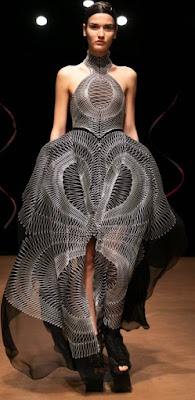Research: Iris van Herpen's techniques
As a follow-up on my last research post, I decided to explore more on the techniques Iris van Herpen uses that makes her designs so unique and innovative.
Most of her designs are created using 3D laser. On her 2020 collection, Sensory Seas, she used cut silk heat-bonded ( glued together with heat) to transparent glass organza before being hand-embroidered onto laser-cut pearlescent exoskeletons.
Hypertube technique
The ‘Hypertube’ technique is created by 3D printing a single-lined web of white silicone thread onto black silk chiffon.
Hydrozoa technique
The ‘Hydrozoa’ technique uses glass organza in tones of dark purples and turquoise which have been created through oil-painting but have been digitally printed, heat-bonded and then hand-stitched onto hundreds of transparent laser-cut PetG (Polyethylene terephthalate, polymeric resin) bubbles.
From a pure innovation point of view, manufacturers sometimes do not think something is possible until they are asked by a designer or a house if they can do it and are challenged to try and make the impossible work. For this very reason, I look up to Iris van Herpen, since she is always pushing the limits of fashion and experimenting with new techniques and concepts.
References:
The Cutting Class. 2020. Contemporary Couture Techniques at Iris van Herpen. [online] Available at: <https://www.thecuttingclass.com/contemporary-couture-techniques-at-iris-van-herpen/> [Accessed 22 May 2021].



Some of van Herpen's designs are breathtaking. Consider and follow up with how you think a designer like van Herpen has an influence on your project and how you can contextualise that.
ReplyDelete